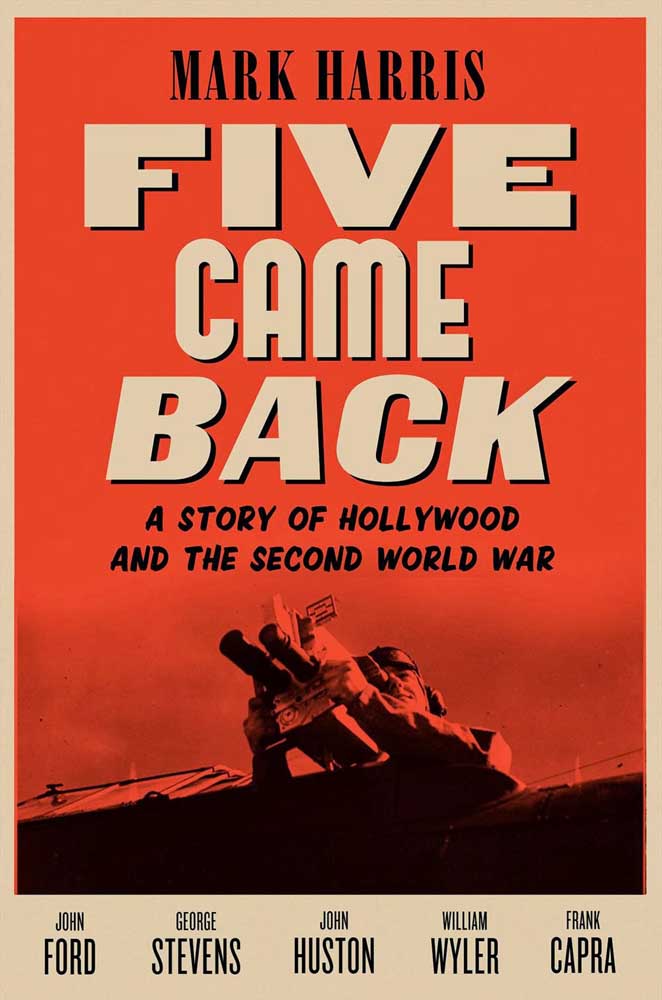‘Why We Fight’: the films of WWII
Published 12:00 am Sunday, March 16, 2014

- ‘Why We Fight’: the films of WWII
“Five Came Back: A Story of Hollywood and the Second World War”by Mark Harris (Penguin Books, 511 pgs., $29.95)
Despite the certainty of war in Europe in 1939, for the most part Hollywood was leery of movies about the Nazi threat. When filmmakers John Ford and George Stevens proposed politically urgent feature films, the studio brass thwarted their efforts.
Trending
Warner Bros. broke the isolationist ice by releasing “Confessions of a Nazi Spy” — billed as “The Picture That Calls a Swastika a Swastika!” — on the same day Hitler announced that the subjugation of Poland was central to Germany’s goals.
Even so, there was pushback. In “Five Came Back,” Mark Harris’ can’t-put-it-down history of World War II propaganda films, he writes that advocates of neutrality in the Production Code office “argued that the movie courted disaster by failing to depict Hitler’s unchallenged social and political achievements.”
Author of the likewise superlative “Pictures at a Revolution,” Harris structures his book cinematically, with establishing shots of this transformational era and close-ups on each of its five subjects. By crosscutting the personal journeys and wartime films of five Hollywood directors — Ford, Stevens, Frank Capra, John Huston and William Wyler — Harris shows how the war changed the filmmakers and how the filmmakers changed the cinematic language and content of Hollywood movies.
“Five Came Back” focuses primarily on the period from 1941, when Ford enlists in the Navy a month before Pearl Harbor, to 1945, as Stevens meticulously documents what he found at Dachau.
Before the U.S. declaration of war, studio heads, many of them Jewish, faced attack from isolationists within the industry and in the Senate. Anti-Semites such as Charles Lindbergh and Sen. Gerald P. Nye, R-N.D., accused the moguls of political agitation, interventionism and Communism. Nye demanded a Senate hearing, which was called off on Dec. 8, 1941, the morning after the attack on Pearl Harbor.
Almost overnight the “competing principalities” of Hollywood and Washington allied in the war effort to make propaganda films for civilians and training films for GIs. For Ford, “naval service represented the last chance to live the seafaring life he had always dreamed of.” Wyler and Capra, both immigrants, were recruited by Signal Corps, but both would have enlisted out of gratitude to their adopted country.
Trending
Stevens, noted for his comedies, volunteered for the Signal Corps because he wanted to make movies with relevance. And Huston, exhausted from hiding his lover, Olivia de Havilland, from his wife, Lesley, accepted a Signal Corps commission as an opportunity to redefine himself as a man of action in the original sense of the expression.
“Within the Signal Corps, there was stiff resistance to any movie that would use plot or character, animation techniques, or even nonmilitary music to drive home its point,” Harris writes. Fortunately, Gen. George Marshall (who in the postwar period developed the Marshall Plan) overrode the complaints.
Marshall assigned Capra, who remained in Washington throughout the war, to supervise the movies collectively known as “Why We Fight.” Capra, shattered by Leni Riefenstahl’s Hitler glorification “Triumph of the Will,” used Axis propaganda to motivate American soldiers. “Let our boys hear the Nazis and the Japs shout their own claims of master-race crud,” Capra said. Capra would produce “The Negro Soldier” (1943), a recruiting movie in the guise of a chronicle of African American achievement.
In the midst of the action
Harris writes with you-are-there intimacy, taking the reader to Midway, where John Ford, awakened by the noise, films an aerial battle that turned out to be a turning point in the war in the Pacific and was blown off his feet by an enemy bomb, his camera still running. Proprietary about his footage and wary of it being cut up into parts for newsreels, Ford defied Navy protocol, secretly editing “The Battle of Midway” (1942) in a week and supplementing it with narration by professional actors.
“The juddering, jolting, damaged images captured at Midway had, it turned out, created a new standard for realism,” Harris writes. “Lack of polish was taken as a benchmark of veracity.”
Stationed in Alaska, where he expected an attack by the Japanese Imperial Navy, Huston took a more straightforward approach with “Report From the Aleutians” (1943). It explained the tactical significance of islands 500 miles away from Japanese-occupied territory and the tense boredom of soldiers waiting for engagement with the enemy.
“Adroit use of newsreel footage was no longer enough,” Harris observes. “Moviegoers didn’t want the story behind the war — they wanted the war brought home in pictures they couldn’t see anywhere else.”
By 1944, American moviegoers — like many soldiers and sailors overseas — had battle fatigue, preferring escapist entertainment to war movies. There were exceptions. Wyler’s “Memphis Belle” focused on the mission and the personality of each man in the “Flying Fortress,” jolting audiences out of their apathy.
The recording of the D-Day invasion and its aftermath (supervised by Ford and Stevens) was a film record “without precedent in the history of warfare.” The processed footage was shown immediately to Churchill and Roosevelt and made it to U.S. theaters in a little over a week.
Ford returned to Hollywood to make “They Were Expendable” (1945), about the 1941 Battle of the Philippines. Wyler lost his hearing while taking aerial footage over Italy, because of the roar of the plane’s engines. Stevens went to Dachau when the crematoria were still burning. He saw evidence of cannibalism. “We went to the woodpile,” he said, “and the woodpile was people.”
He stayed there for weeks. He then made two feature-length documentaries. The first recorded crimes and conditions at Dachau and other camps. The second, “The Nazi Plan,” demonstrated that the death camps were the result of a decade of planning. “The films were intended to have only one showing, and only one audience: the judges at Nuremberg.”
After their service, all five directors returned to Hollywood. Their films became more naturalistic and socially engaged. You may have heard of Capra’s “It’s a Wonderful Life,” Ford’s “The Man Who Shot Liberty Valance,” Huston’s “Treasure of the Sierra Madre,” Stevens’ “A Place in the Sun” and Wyler’s “The Best Years of Our Lives.” War changed them, and their films changed us.








